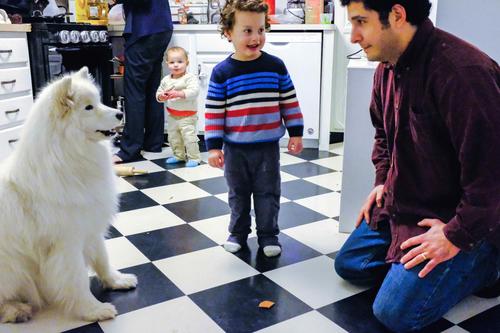
Since opening in 2013, the Canine Cognition Center at Yale has become a hub of scientific outreach to Yale, New Haven, and surrounding communities. Laurie Santos, the center’s founder and professor of psychology, estimates that during its first five years the center conducted research with more than 500 dogs. Participant dog guardians, Santos affirms, hail from “all walks of life and all kinds of backgrounds—from really busy M.D.-Ph.D. students to retirees who live with their dogs, and even faculty—all of whom share this real interest and curiosity for what their dogs know about the world.” Some participants have travelled from as far as Pennsylvania and Vermont to contribute to one of the foremost research facilities in the field of canine cognition.
The center’s research focuses on two key questions: which cognitive features are shared by dogs and humans, and what makes the human mind distinctive? While investigating this second question early in her career, Santos worked with non-human primates, humans’ closest living relatives, in hopes of insight into what might be unique about the human mind. Over time, however, research in the field increasingly suggested that the distinctiveness of human cognition derives as much from human environments as from human nature.
This discovery led scientists around the world, including Santos, to focus their research on canine cognition. Given their domestication millennia ago, dogs uniquely possess the experience of living as non-humans in human households, surrounded by human language. They thus provide scientists with an advantageous comparison by which to assess which aspects of human cognition are unique, and which are shared with other animals who merely inhabit the same environment.
For example, a study conducted at the center and published in peer-reviewed scientific journal Developmental Science in 2016 reported on dogs’ degree of overimitation. When studied in humans, overimitation refers to young children’s tendency to copy all of an adult model’s actions, even components that are clearly irrelevant for a task at hand: “When [children] see somebody do something intentionally, [they] assume that is how [they] are supposed to act on the world and [they] tend to copy that, even when this intentional action seems pretty irrelevant for the task at hand,” Santos explains.
For the 2016 canine study, researchers at the center presented dogs with a simple puzzle box containing a treat. One of the researchers would then solve the puzzle while the dog watched, pulling unnecessarily on a lever. The dog would then be allowed to try to acquire the treat. Researchers found that dogs would not imitate the unnecessary step—or overimitate—once they came to understand which actions were essential and which were superfluous. Children, by contrast, tend to mimic all modeled actions, happily pulling on the lever. This behavior is of paramount importance to infants, who mirror actions of adults around them, such as brushing teeth and using utensils, even when they cannot fully grasp their importance.
Two recurring participants in the center’s research projects are assistant professor of philosophy Daniel Greco, and Bianca, his fluffy white Samoyed (pictured above). Greco recalls being blindfolded in one study to avoid giving unintentional cues to Bianca as he held her leash. As we walk Bianca around the block, Greco also handling his son’s stroller, he recounts to me the story of Clever Hans, a horse that could supposedly solve mathematical operations by stomping his feet an amount of times equivalent to the answer. Hans was, of course, no genius in comparison to his fellow horses; rather, it turns out his owner was changing his demeanor once the right number of stomps had occurred, which the horse would readily pick up on. Like Clever Hans, Bianca also displayed an ordinary intelligence unaided by Greco’s cues. She still pulls on her leash, Greco adds, every time they pass the center, seeking once more to use her ingenuity to retrieve doggie treats.
 Like Greco, other Yale faculty members have participated in the center’s scientific efforts from its early days, when the center received wide press coverage, alerting a community of curious dog guardians. Zoe, the dog belonging to senior lector II in German Theresa Schenker (pictured on the right), has collected nearly every “diploma” a dog can earn from the center, graduating six times from different research projects. Nevertheless, Schenker reports that Zoe is still unable to solve the hardest puzzles in her favorite toy: a box with treats hidden inside compartments with escalating levels of complexity. For the center, however, the only requirements for participating dogs are that they be vaccinated and that they complete an initial visit to confirm the dog’s comfort with the center. This is tested by feeding dogs on different surfaces and recording their reactions.
Like Greco, other Yale faculty members have participated in the center’s scientific efforts from its early days, when the center received wide press coverage, alerting a community of curious dog guardians. Zoe, the dog belonging to senior lector II in German Theresa Schenker (pictured on the right), has collected nearly every “diploma” a dog can earn from the center, graduating six times from different research projects. Nevertheless, Schenker reports that Zoe is still unable to solve the hardest puzzles in her favorite toy: a box with treats hidden inside compartments with escalating levels of complexity. For the center, however, the only requirements for participating dogs are that they be vaccinated and that they complete an initial visit to confirm the dog’s comfort with the center. This is tested by feeding dogs on different surfaces and recording their reactions.
As a facility that holds a promise of working with the community within and beyond Yale, the Canine Cognition Center delivers. Santos and other staff members engage in public science outreach, giving talks within New Haven and beyond. This canine-human community also gathers periodically for “Howl-o-ween” costume contests or collections of donated food, toys, and blankets for local non-profit animal welfare groups. The center thus bridges the gap between the scientific and the curious, the school and the city, the animal-lover and the dog seeking nothing more than the reward of another treat.
Reported by Christian de León for the Faculty of Arts and Sciences Dean’s Office.